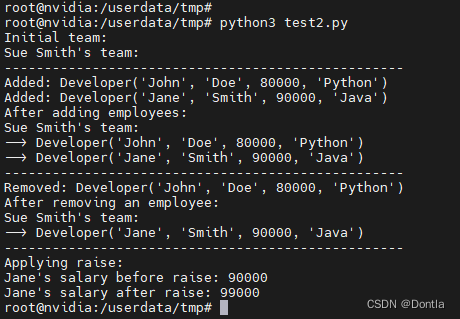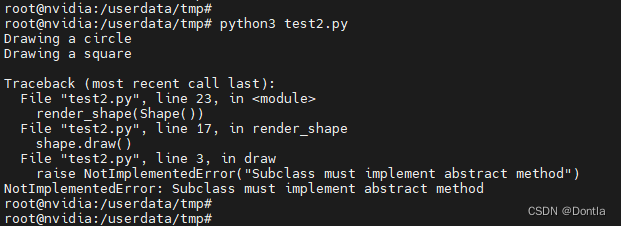文章目录
- Python 类的优势及应用场景深度分析
- 1. 代码封装与组织
- 1.1 封装性
- 示例代码:用户账户管理
- 1.2 组织性
- 2. 继承与代码复用
- 2.1 继承性
- 示例代码:员工管理系统
- 3. 多态与接口
- 3.1 多态性
- 示例代码:图形渲染
- 4. 状态管理与行为的封装
- 4.1 状态的持久化:类可以持久化内部状态,而闭包或全局变量在这方面通常表现得不那么直观和安全。
- 示例代码:游戏状态管理
Python 类的优势及应用场景深度分析
Python 是一种广泛使用的高级编程语言,其支持多种编程范式,包括面向对象编程(OOP)。使用 Python 类相较于其他解决方案在多个方面展示出显著优势,尤其在代码的组织、可维护性、扩展性及多态性方面。本文将深入探讨使用类的优势,并通过具体的代码示例阐明其在特定应用场景下的应用价值。
1. 代码封装与组织
1.1 封装性
类通过封装技术允许数据(属性)和代码(方法)被包裹在一个单独的自包含对象中。这种封装性不仅帮助保护数据的完整性,还提高了代码的可读性和易维护性。
示例代码:用户账户管理
class Account:def __init__(self, owner, balance=0):self.owner = ownerself.__balance = balance # 私有属性def deposit(self, amount):if amount > 0:self.__balance += amountprint(f"Added {amount} to the balance")else:print("Deposit amount must be positive")def withdraw(self, amount):if 0 < amount <= self.__balance:self.__balance -= amountprint(f"Withdrew {amount} from the balance")else:print("Invalid withdrawal amount")def get_balance(self):return self.__balance# 使用
acc = Account("John")
acc.deposit(100)
print(acc.get_balance()) # 输出: 100
acc.withdraw(50)
print(acc.get_balance()) # 输出: 50

1.2 组织性
类提供了一种自然的方式来将相关功能组织在一起。这种组织性使得开发者能够以模块化的方式构建和维护复杂系统。
2. 继承与代码复用
2.1 继承性
继承允许新的对象类基于现有的对象类定义。这不仅减少了代码的重复,还增强了代码的可维护性。
示例代码:员工管理系统
class Employee:raise_amount = 1.04 # 基本涨薪比例def __init__(self, first, last, pay):self.first = firstself.last = lastself.pay = paydef email(self):return f"{self.first}.{self.last}@company.com"def apply_raise(self):self.pay = int(self.pay * self.raise_amount)return self.paydef __repr__(self):return f"Employee('{self.first}', '{self.last}', {self.pay})"class Developer(Employee):raise_amount = 1.10 # 开发者涨薪比例def __init__(self, first, last, pay, prog_lang):super().__init__(first, last, pay)self.prog_lang = prog_lang # 编程语言def __repr__(self):return f"Developer('{self.first}', '{self.last}', {self.pay}, '{self.prog_lang}')"class Manager(Employee):def __init__(self, first, last, pay, employees=None):super().__init__(first, last, pay)if employees is None:self.employees = []else:self.employees = employeesdef add_emp(self, emp):if emp not in self.employees:self.employees.append(emp)print(f"Added: {emp}")def remove_emp(self, emp):if emp in self.employees:self.employees.remove(emp)print(f"Removed: {emp}")def print_emps(self):print(f"{self.first} {self.last}'s team:")for emp in self.employees:print('-->', emp)# 使用改进后的代码
dev1 = Developer('John', 'Doe', 80000, 'Python')
dev2 = Developer('Jane', 'Smith', 90000, 'Java')
mgr = Manager('Sue', 'Smith', 90000)print("Initial team:")
mgr.print_emps()print('-' * 50)# 添加员工
mgr.add_emp(dev1)
mgr.add_emp(dev2)# 打印添加后的员工名单
print("After adding employees:")
mgr.print_emps()print('-' * 50)# 删除一个员工
mgr.remove_emp(dev1)# 打印删除后的员工名单
print("After removing an employee:")
mgr.print_emps()print('-' * 50)# 应用并打印涨薪后的薪水
print("Applying raise:")
print(f"{dev2.first}'s salary before raise: {dev2.pay}")
dev2.apply_raise()
print(f"{dev2.first}'s salary after raise: {dev2.pay}")
3. 多态与接口
3.1 多态性
多态性允许不同类的对象被视为同一类型的实例。这增加了程序的灵活性和扩展性。
示例代码:图形渲染
class Shape:def draw(self):raise NotImplementedError("Subclass must implement abstract method")class Circle(Shape):def draw(self):print("Drawing a circle")class Square(Shape):def draw(self):print("Drawing a square")def render_shape(shape):shape.draw()render_shape(Circle()) # 输出: Drawing a circle
render_shape(Square()) # 输出: Drawing a square
# 输出: NotImplementedError: Subclass must implement abstract method
render_shape(Shape())
4. 状态管理与行为的封装
4.1 状态的持久化:类可以持久化内部状态,而闭包或全局变量在这方面通常表现得不那么直观和安全。
示例代码:游戏状态管理
class Game:def __init__(self, level=0):print("Game initialized")self.level = leveldef level_up(self):self.level += 1print(f"Welcome to level {self.level}")def restart(self):self.level = 0print("Game restarted")game = Game() # 输出: Game initialized
game.level_up() # 输出: Welcome to level 1
game.restart() # 输出: Game restarted
在深入探讨 Python 类的这些优势后,可以清楚地看到,尽管其他编程技巧如函数或模块也可用于解决类似问题,但在需要结构化和可维护的大规模应用程序中,类提供了无可比拟的优势。这些优势使得 Python 类成为设计复杂系统时的首选工具。



A股行总结:A股震荡收涨,车路云概念全日强势,10年、30年国债期货齐创新高)
)


 【含Matlab源码 MX_003期】)
:观看各个视频的平均完播率)


 RTT打印调试日志)
招投标用,虽然有内定潜规则,但是方案都是要的,不一定就是价格低就能中标,毕竟是上百万以上的单子)
——无语义的布局标签和字符实体)


的污染物排放量进行研究预测)


